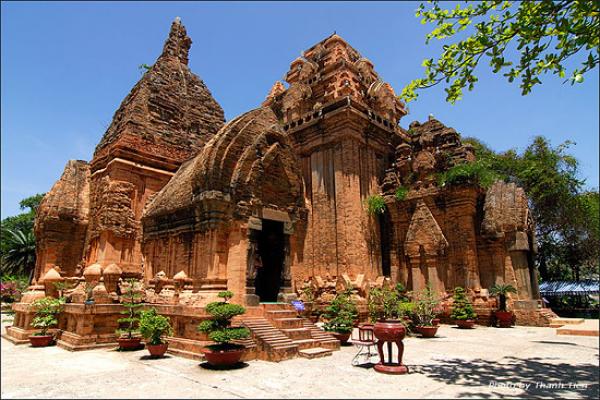 The Champa civilization was located in the more southern part of what is today Central Vietnam, and was a highly Indianized Hindu Kingdom, practicing a form of Shaivite Hinduism brought by sea from India. Mỹ Sơn, a Hindu temple complex built by the Champa is still standing in Quang Nam province, in Vietnam.
The Champa civilization was located in the more southern part of what is today Central Vietnam, and was a highly Indianized Hindu Kingdom, practicing a form of Shaivite Hinduism brought by sea from India. Mỹ Sơn, a Hindu temple complex built by the Champa is still standing in Quang Nam province, in Vietnam.
The Champa were conquered by the Vietnamese and today are one of the many ethnic minorities of Vietnam. Hindu temples are known as Bimong in Cham language and the priests are known as Halau Tamunay Ahier.
The Balamon Hindu Cham people of Vietnam make up only 25% of the overall Cham population (the other 75% are Muslims or Cham Bani). Of these, 70% belong to the Nagavamshi Kshatriya caste (pronounced in Vietnamese as “Satrias”), and claim to be the descendants of the Champa Empire. A sizeable minority of the Balamon Hindu Cham are Brahmins.
 In all, approximately 50,000 Chams in Vietnam are Hindu, with another 4,000 Hindus living in Ho Chi Minh City; some of these are ethnic Cham, but most are Indian (Tamil) or of mixed Indian-Vietnamese descent.
In all, approximately 50,000 Chams in Vietnam are Hindu, with another 4,000 Hindus living in Ho Chi Minh City; some of these are ethnic Cham, but most are Indian (Tamil) or of mixed Indian-Vietnamese descent.
The Mariamman Temple is one of the most notable Hindu temples in Ho Chi Minh City. In Ninh Thuan Province, where most of the Cham in Vietnam reside, Cham Balamon (Hindu Cham) numbers 32,000; Out of the 22 villages in Ninh Thuan, 15 are Hindu.
During vietnam war, lot of these temples abandoned or ruined. No hindu organization helps them except archeological survey of india and UNESCO. Source
The ruins of Champa civilization towers on the north side of Nha Trang, Vietnam.
The work of Cham religious art which scholars conventionally call the “Tra Kieu Pedestal,” but which might more descriptively be called the “Krishna Pedestal,”
As Hindus and users of Sanskrit as a formal language, the medieval Cham were heirs to the civilization and mythology of India, in which Nagas played an important role.



























Jai hindutva we r proud for vietname hindu